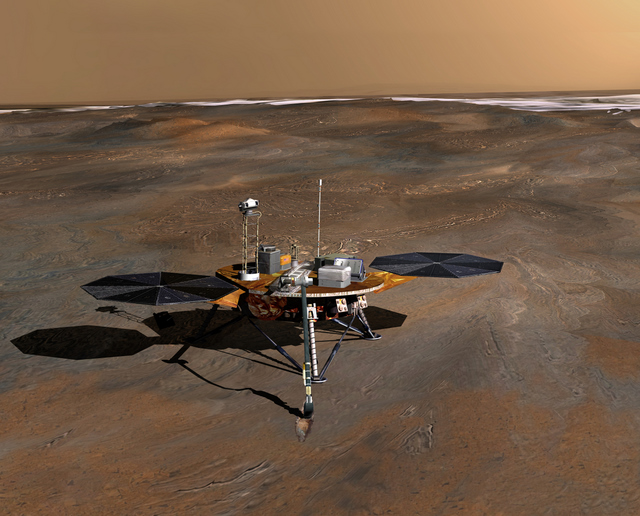[/caption]
Cold weather and a dust storm are likely contributors to why NASA’S Phoenix Mars Lander went into a “safe mode” late Tuesday. The lander experienced a low-power fault in the electrical system. While engineers anticipated that a fault could occur due to the diminishing power supply, the lander also unexpectedly switched to the “B” side of its redundant electronics and shut down one of its two batteries. During safe mode, the lander stops non-critical activities and awaits further instructions from the mission team. The good news is that within hours of receiving information of the safing event, mission engineers at JPL and Lockheed Martin in Denver, were successfully able to send commands to restart battery charging. So, it is not likely that any energy was lost. And Phoenix is still Twittering,, which is good news, too!
Weather conditions at the landing site in the north polar region of Mars have deteriorated in recent days, with overnight temperatures falling to –141F (-96C), and daytime temperatures only as high as -50F (-45C), the lowest temperatures experienced so far in the mission. A mild dust storm blowing through the area, along with water-ice clouds, further complicated the situation by reducing the amount of sunlight reaching the lander’s solar arrays, thereby reducing the amount of power it could generate. Low temperatures caused the lander’s battery heaters to turn on Tuesday for the first time, creating another drain on precious power supplies.
Science activities will remain on hold for the next several days to allow the spacecraft to recharge and conserve power. Attempts to resume normal operations will not take place before the weekend.
“This is a precarious time for Phoenix,” said Phoenix Project Manager Barry Goldstein of JPL. “We’re in the bonus round of the extended mission, and we’re aware that the end could come at any time. The engineering team is doing all it can to keep the spacecraft alive and collecting science, but at this point survivability depends on some factors out of our control, such as the weather and temperatures on Mars.”
The ability to communicate with the spacecraft has not been impacted. However, the team decided to cancel communication sessions Wednesday morning in order to conserve spacecraft power.
Just a day ago, the mission announced plans to turn off four heaters, one at a time, in an effort to preserve power. The faults experienced late Tuesday prompted engineers to command the lander to shut down two heaters instead of one as originally planned. One of those heaters warmed electronics for Phoenix ‘s robotic arm, robotic-arm camera, and thermal and evolved-gas analyzer (TEGA), an instrument that bakes and sniffs Martian soil to assess volatile ingredients. The second heater served the lander’s pyrotechnic initiation unit, which hasn’t been used since landing. By turning off selected heaters, the mission hopes to preserve power and prolong the use of the lander’s camera and meteorological instruments.
But everything is on a downward trend. As the Martian northern hemisphere shifts from summer to autumn, less sunlight is reaching Phoenix’s solar panels. “It could be a matter of days, or weeks, before the daily power generated by Phoenix is less than needed to operate the spacecraft,” said JPL mission manager Chris Lewicki. “We have only a few options left to reduce the energy usage.” But Phoenix is into the fifth month of a 90-day mission — we should all be thankful we’ve had the little lander with us for as long as we have….
Source: JPL


besides close up images of dirt, are there any other noteworthy results out yet?
Don’t forget: it proved the EXISTENCE OF WATER ICE ON MARS! There is frozen water ice below just a few inches of Martian soil! This is a major discovery. Now we know that when we send people to Mars there will be ice to melt.
The lander is also showing us seasonal changes in weather and temperature in the Northern region of Mars.
Go Phoenix!
the “images of dirt” are only a tiny aspect of what my namesake sent back to Earth. There are lots of chemistry findings, atmosphere and weather observations, measurements of soil conductivity, optical and atomic force microscopy results… there’s no end to the list…. and part from those images of “dirt”, there are also some cool lanscape shots.
Don’t belittle the accomplishments of my namesake, please.
😉
Sure it’s done some great science, it’s been a tough little battler too, and flexible, and once again the team behind it have probably learnt more, ready for the next one, than any results will attest to. It’s a shame we didn’t find any organics, or see a bug crawl out from under the flipped rock, ( did we ever find out what was ‘growing’ on the lander leg ? ), but what has been proven is that within the area of the arm, there is no observable organics, however, within the area of the arm, there is ice water, and the soil is exactly that, soil .. which confirms the ‘ability’ for some sort of life to have been or be there .. .. Now with the opal discovery, there might be some more money thrown NASA’s way to explore a little more ! I want an ostentatious, garish martian opal ring on my finger before i die !
proved the existance of water ice? you can do that from earth w/ a small telescope. i realize pheonix has done some good science, maybe i just expect more bang for my taxpayer buck.